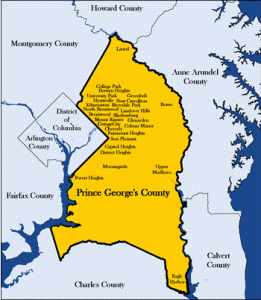Prince George’s County Abandons Anti-Competitive, Budget-Busting Project Labor Agreement on Laurel Library
Another taxpayer-funded project subject to a government-mandated project labor agreement (PLA) in the Washington, D.C., region has run into trouble.
The Baltimore Sun reported that a union-favoring PLA required by Prince George’s County on the construction of the new library in Laurel, Md., has been scrapped because it caused delays, increased costs, and reduced competition from local contractors and construction workers (“Work poised to begin this fall on Laurel library branch,” 10/1/14):
The project, which has been on the books since 2005 and was initially scheduled to break ground in October 2013, experienced a round of delays in the process of choosing a contractor, according to Prince George’s County Councilwoman Mary Lehman, who represents Laurel.
The library, a $14 million project, was originally slated to be built using union labor, but Lehman said she learned in an August meeting that the county’s initial call for proposals had been posted without documentation informing bidders of that intent.
The goal of building the library with union labor stems back to a 2011 bill, sponsored by Councilwoman Karen Toles, which allows the county to use federally authorized craft labor agreements on construction projects worth more than $1 million.
In passing the bill, the council resolved that these contracts, called Project Labor Agreements, “provide a reliable means for ensuring that construction projects will be adequately staffed with sufficient numbers of highly skilled and properly trained craft personnel and, therefore, such agreements promote the efficient, economical and safe completion of such contracts.”
The bill set a goal for the county to bid two PLA projects per year, beginning in fiscal year 2013.
According to Holt, a construction project for a new fire station in Brandywine is already moving forward as a PLA project for this fiscal year.
But NARDI Construction, the non-union, Beltsville-based contractor chosen for the Laurel library project, “was not able to secure and identify enough construction companies to fulfill the PLA requirement,” Holt said.
He said the county did put out a call for union labor on the project, but had to cancel the initial award, also made to NARDI, because “ultimately there wasn’t enough local labor” and the costs proposed by union subcontractors had “escalated beyond the budget appropriated for the project.”
NARDI’s current contract to build the library requires laborers to be paid local prevailing wages, per county law, according to Holt.
As to whether the initial request for proposals omitted any PLA documentation, Holt said: “PLAs are a fairly new issue in the county, so I won’t discount that we’re getting smarter and smarter as we do them, but I think the predicate on this issue was that we weren’t able to identify 100 percent of the classes and labor trades that we needed to and keep the project under budget.”
Several local unions did not return requests for comment by Tuesday.
It should come as no surprise to TheTruthAboutPLAs.com readers that the Laurel Library and the Brandywine Fire Station suffered delays, increased costs, and a lack of local union contractors and construction workers due to discriminatory PLAs mandated by Prince George’s County lawmakers.
We predicted these sad results.
In 2010, we exposed the political corruption behind union lobbyists promoting Prince George’s County Council’s pro-PLA legislation via pay-to-play politics. Despite this egregious and unethical behavior, PG County Council Member Karen Tole’s (D-District 7) legislation, CB-16, eventually passed on Nov. 15, 2011, even though the Maryland Minority Contractors Association, the National Black Chamber of Commerce and other construction stakeholders said it would needlessly increase costs and harm local and minority businesses and construction workers.
Anti-competitive government-mandated PLAs are special interest kickback schemes that end open, fair and competitive bidding on construction projects and steer contracts and jobs to well-connected unionized contractors and unionized construction workers.
PLAs typically force contractors to hire most or all of their craft professionals from union hiring halls; follow inefficient union work rules; hire apprentices exclusively from union apprenticeship programs; and pay into union benefit plans on behalf of any existing employees, even if they have their own qualified benefit programs. PLAs force employees to pay union dues, accept unwanted union representation, and forfeit benefits earned during the life of a PLA project unless they join a union and become vested in union benefit plans.
In short, PLAs discourage or eliminate local and qualified merit shop contractors from competing for and winning contracts on construction projects as they are almost always awarded exclusively to unionized contractors and their all-union workforces.
Union lobbyists claim PLAs result in a safe, on-time and on-budget project, using local union labor. But PLAs in the Mid-Atlantic region have been plagued by delays, accidents, cost overruns and few jobs for local residents, despite promises made by PLA proponents.
Busting the Myth That PLAs Result in Increased Local Hiring
Because construction unions represent only 8.9 percent of Maryland’s construction workforce and 14.9 percent of the District of Columbia’s workforce (see Table II at unionstats.com), unions often have to import craft workers from outside the region in order to fully staff a project.
This reality was brought home during the budget-busting construction of the National’s baseball stadium in Washington, D.C., where union lobbyists convinced the D.C. City Council to require a PLA on the project, which forced contractors to follow inefficient union work rules and hire most or all of their construction workers through union hiring halls from as far away as Philadelphia.
Contained within this agreement were promises by union officials to meet local hiring requirements and funnel D.C. residents exclusively into union apprenticeship programs. Hiring data documented by a 2009 report, “The True Cost of the Washington Nationals Ballpark Project Labor Agreement,” found unions broke their local hiring promises.
For example, just 26 percent of journeymen hours went to D.C. residents, rather than the 50 percent unions promised in the agreement. Additional data and another report on the D.C. stadium revealed that half of the contractors involved in the project hired no new apprentices; of the companies that hired new trainees, only 17 of 56 met the PLA requirement that 100 percent of new apprenticeships go to D.C. residents.
In addition, on the controversial Maryland Department of General Services’ (DGS) Juvenile Detention Center currently under construction in Cheltenham, more than two-thirds of the contractors are from states other than Maryland—some from as far away as Minnesota.
Data collected by Del. Eleanor Holmes-Norton (D) on federal projects subject to PLAs in the District of Columbia demonstrated that PLAs delivered worse local hiring outcomes than other large-scale federal project not subject to a PLA.
Local hiring data collected by the Metropolitan Washington Airport Authority for Phase 1 of the $2.8 billion Silver Line project in Northern Virginia found subcontractors performing work without a PLA hired a greater percentage and number of local workers than the prime contractor performing under a voluntary PLA.
PLAs Result in Delays and Increased Costs
Research has found less competition and archaic and inefficient union rules increase the cost of construction projects subject to PLAs between 12 percent and 18 percent, on average. In addition to the anecdotal evidence provided by the Laurel Library and the Brandywine Fire Station PLA experiences, federal projects in the District of Columbia subject to President Obama’s February 2009 Executive Order 13502 encouraging federal agencies to require PLAs on a case-by-case basis on federal projects exceeding $25 million have experienced delays and budgets overruns.
One of the U.S. General Services Administration’s (GSA) first government-mandated PLA projects, the renovation of the agency’s headquarters at 1800 F St., in Washington, D.C., suffered millions of dollars in increased costs and a 107-day delay as a result of a PLA. The prime contractor, a Whiting-Turner Walsh Joint Venture (JV), could not reach a finalized PLA with all of the local construction trade unions so the GSA told the JV to proceed with construction without a PLA (see related blog post here).
On the GSA’s Lafayette Building in D.C., the GSA and Grunley Construction agreed to a change order for an additional $3.3 million to build the project with a PLA even though the contract had already been awarded without a PLA for $52.3 million.
Coupled with D.C.’s poor experience with government-mandated PLAs related to local hiring, quality, cost and timeliness on local, state and federal projects (see problems with the Wilson Bridge, D.C. Convention Center and Nationals Stadium documented here), it’s curious why Maryland and D.C. lawmakers continue to entertain these schemes and taxpayers tolerate such poor results.
Lawmakers should be encouraging fair and open competition by restricting government-mandated PLAs through legislation similar to what was passed in Anne Arundel County, Md., in 2012.
Recent and Ongoing PLA Threats
Taxpayers, lawmakers, the media and the contracting community should be monitoring the following potential PLA threats on large projects in the District of Columbia and Maryland.
In September 2013, outgoing District of Columbia Mayor Vincent Grey required a PLA on the $300 million DC United soccer stadium at the Buzzard Point area in Southwest Washington, D.C., which we exposed here.
In October 2013, an effort to require PLAs on Charles County, Md., projects by some member of the Charles County Commission was exposed and stalled. The contracting community expects Charles County lawmakers to entertain this failed policy again in 2015.
The privately financed (but Maryland government-approved) $925 million MGM National Harbor Casino in PG County scheduled to open in July 2016 is subject to a PLA.
In 2013, Maryland Gov. Martin O’Malley (D) encouraged the use of PLAs or apprenticeship programs on state-funded construction projects through an executive order.
There are rumors of government-mandated PLAs on the District of Columbia Department of Transportation’s (DDOT) $900 million project to replace the Frederick Douglass Memorial Bridge (aka the South Capitol Street Bridge), the largest infrastructure project ever to be undertaken by the District, and the DDOT’s $1.3 billion project to construct a 22-mile streetcar line that is planned to be the district’s first-ever design-build-maintain-finance-operate project. PLAs on these DC projects will likely be determined by the outcome of the Nov. elections.
The Maryland Department of Transportation’s $2.37 billion dollar Purple Line metro project linking Montgomery County to Prince George’s County is subject to a PLA preference, which some argue is a de facto PLA mandate.
Get Engaged
Concerned taxpayers should contact the Prince George’s County Council and ask them to repeal CB-16 and say NO to government-mandated project labor agreements so more projects do not suffer the same fate as the Brandywine Fire Station, the Laurel Library, and many of the other failed PLA projects in the D.C. metro region. Taxpayers deserve fair and open competition, which delivers schools, libraries and highways at the best quality and price.
UPDATE:
On Oct. 12, 2014, Center Maryland’s blog ran an Op-Ed about Maryland PLAs here: Mike Henderson and Debra Schoonmaker: Project Labor Agreements Hurt Local Workers and Make Construction More Expensive — So Why Are Local Politicians Still Pushing Them? Give it a read.













